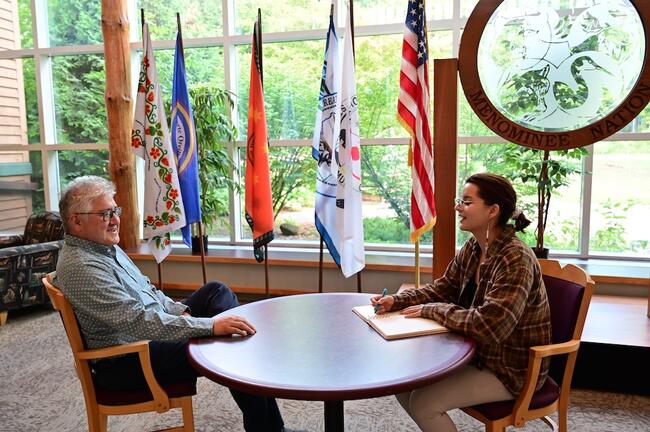You have /5 articles left.
Sign up for a free account or log in.

Chris Caldwell, president of College of Menominee Nation, sits with a student on campus. His institution could suffer under a proposed reduction to tribal college funding from the Department of the Interior.
Rich Montour
Tribal college leaders fear for their institutions’ survival after a budget cut proposed by the U.S. Department of the Interior.
The budget request from the Department’s Bureau of Indian Education to Congress, made public earlier this month, would chop the department’s operational funding to tribal colleges by a whopping 83 percent, a shortfall of more than $105 million. The department asked for about $22 million for tribal colleges for the coming fiscal year, down from roughly $127 million in 2024.
Tribal college leaders say, if Congress approves the cut, it would shutter already cash-starved colleges and limit higher ed access and job opportunities for surrounding tribal and rural communities. President Donald Trump’s budget also zeroed out funding for the Institute for American Indian Arts, a Native American art school in Santa Fe, N.M. Neither the House nor the Senate has yet to propose its own budget for the Interior Department, so it’s unclear if lawmakers will agree. But even so, the proposed cuts have already shaken tribal college students and made some question whether to enroll next year.
On top of these concerns, the Bureau of Indian Education is facing drama of its own. It’s come under more scrutiny from federal lawmakers over its stewardship of Haskell Indian Nations University and Southwestern Indian Polytechnic Institute, the two tribal universities under its direct control. (The rest are chartered by tribes.) A group of Republican lawmakers proposed removing Haskell from the bureau’s oversight entirely. Some tribal college leaders worry the negative attention on the two institutions doesn’t bode well as other institutions plead with Congress not to enact proposed cuts.
In a statement, a Bureau of Indian Education spokesperson told Inside Higher Ed that agency officials remain “committed to providing high-quality education that honors the unique needs and cultures of Native students.”
“We will continue to advance academic excellence, student well-being, and culturally relevant instruction with the resources entrusted to us,” the spokesperson said.
Ahniwake Rose, president of the American Indian Higher Education Consortium, called the size of the proposed cut “drastic” and “devastating.”
She knew the Trump administration tasked federal agencies with making sweeping cuts to reduce federal spending, but she was shocked to see tribal colleges bear the brunt of them from the Department of the Interior, she said. The colleges’ other two primary federal funding sources, the Department of Education and the Department of Agriculture, proposed flat funding for the institutions for the next fiscal year.
She stressed that the country’s 37 tribal colleges tend to receive little to no state funding, lack large endowments and have been “woefully underfunded” by the federal government since their inception. A ProPublica investigation found that Congress underfunds tribal colleges by roughly a quarter of a billion dollars annually, consistently failing to pay the inflation-adjusted amount owed to them under the laws that authorized their creation. As a result, they struggle with crumbling infrastructure and are already operating on shoestring budgets.
“Without the Interior funding, our institutions will close,” Rose said.
Since news of the proposed budget came out, she said, student and employee morale at tribal colleges has plummeted.
“We have students that are questioning whether tribal colleges are the right place to attend,” she said. They’re asking, “should they be coming back if their education is at stake.” As a student, ideally, “the last thing in the world you’re thinking about is whether the institution will be standing next year.”
Stephen Schoonmaker, president of Tohono O’odham Community College in Arizona, said even if the cut doesn’t happen, it’s made students hesitant to enroll, so “there’s already been damage.”
College officials at Tohono O’odham have been trying to stress to nervous students that “all of these budgets are proposals, and while they are stark and scary, they are still just proposals,” he said. “It’s incumbent upon us not to sugarcoat this … At the same time, I think it’s also incumbent upon us to say, this isn’t resolved.”
A ‘Gut Punch’
The budget proposal leaves tribal colleges in limbo, unsure of how to budget for the coming year amid a vastly uncertain and potentially crippling funding landscape.
Chris Caldwell, president of the College of Menominee Nation in Wisconsin, worries his institution, its students and the local economy will suffer if the cut comes to pass.
He described the College of Menominee Nation as small in size—serving roughly 250 students—but large in impact. It’s a job provider for the Menominee Indian Reservation and its surrounding county, employing upward of 200 locals and, as a result, pouring millions of dollars into the local economy, according to a recent impact study. It partners with local employers, like the tribe’s sawmill and forestry operation, on research and workforce development projects. And college leaders take pride in ramping up student support services since the pandemic through the college’s Indigenous Wellness Center.
He doesn’t want to lose that growth and progress.
“We really wanted to work with the administration to demonstrate, even with underinvestment, this is what we could do,” Caldwell said. “And just think of what more could be done if there was more investment.”
He said if the proposed cut is enacted, the college would likely have to make personnel cuts and slash degree programs as well as student supports.
The Interior Department budget proposal comes after many tribal colleges already wrestled with budgetary uncertainty earlier this year amid sudden grant freezes. The Department of Agriculture froze and then returned two of the College of Menominee Nation’s grants, and the institution is still waiting to find out if grants from the Institute of Museum and Library Services will ultimately come through.
“We already live on tight budgets,” Caldwell said. “As soon as we start reducing those supports or the degree programs we’re able to offer, does it become a downhill slide? … Death by a thousand cuts is kind of the picture that begins to emerge.”
Manoj Patil, president of Little Priest Tribal College in Nebraska, believes many tribal colleges wouldn’t survive if the budget proposal became a reality—including his own. He said the college’s administration, business office and financial aid office all run on operating funds that are on the chopping block.
Although he understands the administration’s urge to reduce federal spending, eventually, a college can’t function without “somebody to write scholarship checks, or somebody to get the books for the bookstore, somebody to manage people,” he said.
He called the proposed reduction a “gut punch.”
Without a significant endowment, “no tribal college can withstand this traumatic of a hit,” he said. He wants lawmakers to understand that “our students deserve better, and this is going to be the end of it.”
The BIE on the Hot Seat
As tribal college leaders fear for their funding, the Bureau of Indian Education was thrust into the spotlight at a Tuesday hearing held by the House Subcommittee on Higher Education and Workforce Development and the House Natural Resources Subcommittee on Oversight and Investigations. It was the second bipartisan hearing Congress has held to delve into the bureau’s oversight of Haskell Indian Nations University in Kansas and Southwestern Indian Polytechnic Institute in New Mexico and the challenges facing the institutions.
Rep. Paul Gosar of Arizona, chairman of the Natural Resources Subcommittee, raised concerns about crime, deferred maintenance, graduation rates and management issues at Haskell and SIPI.
“Our tribal students deserve better,” Gosar said.
Policymakers also re-raised concerns about student and employee complaints of misconduct at Haskell, including mishandled sexual assault claims, detailed in a redacted report released by the Bureau of Indian Education in April. Some also mentioned legislation spearheaded by Republican lawmakers in Kansas to bring Haskell under the oversight of a board of regents instead of the bureau.
Some lawmakers focused their comments on chronic underfunding and the Trump administration’s federal staff cuts, which wreaked havoc on Haskell and SIPI earlier this year, before the reductions were reversed. Many also expressed concerns about the budget proposed by the Department of the Interior.
Haskell and SIPI need “support and funding so that they can too live up to the standards that their communities deserve,” said Rep. Alma Adams, a Democrat from North Carolina. “This is why we need the administration to take steps to help these schools. However, from what we’ve seen so far, they’ve done the opposite.”
Scott Davis, a senior adviser to the secretary of the interior who is currently fulfilling the role of assistant secretary of Indian affairs, acknowledged challenges at Haskell and SIPI and promised to tackle them. He’d even “micromanage” the institutions if necessary.
He hedged when asked pointed questions about whether tribal colleges would close if subjected to the proposed Department of the Interior cuts.
“These changes, ebbs and flows, in funding formulas throughout Indian Country are not new to us,” Davis said.
Schoonmaker, of Tohono O’odham Community College, said he was heartened to see lawmakers from both parties raise concerns about underfunding, but it also worried him how little some representatives seemed to know about the institutions. He hopes, in this critical moment for tribal college funding, policymakers don’t let their concerns about the two bureau-run institutions cloud their judgement about tribal colleges over all.
Even for SIPI and Haskell, “this is not the time to withdraw financial assets … to make them suffer with dilapidated facilities because they’ve had some trouble,” he said. “I’m not sure that’s the best path out from their situations, and it certainly is not helpful to us as we’ve been moving ourselves forward post-pandemic to re-establish, to regain, to reassert education and economic development opportunities for our nation.”
Rose, of AIHEC, expects and hopes that Congress won’t move forward with the funding reduction because tribal colleges’ historic bipartisan support.
“We have members who understand the importance of what we do, the importance of our impact in our communities and to Indian Country as a whole, that we’re really going to be relying on,” she said.





